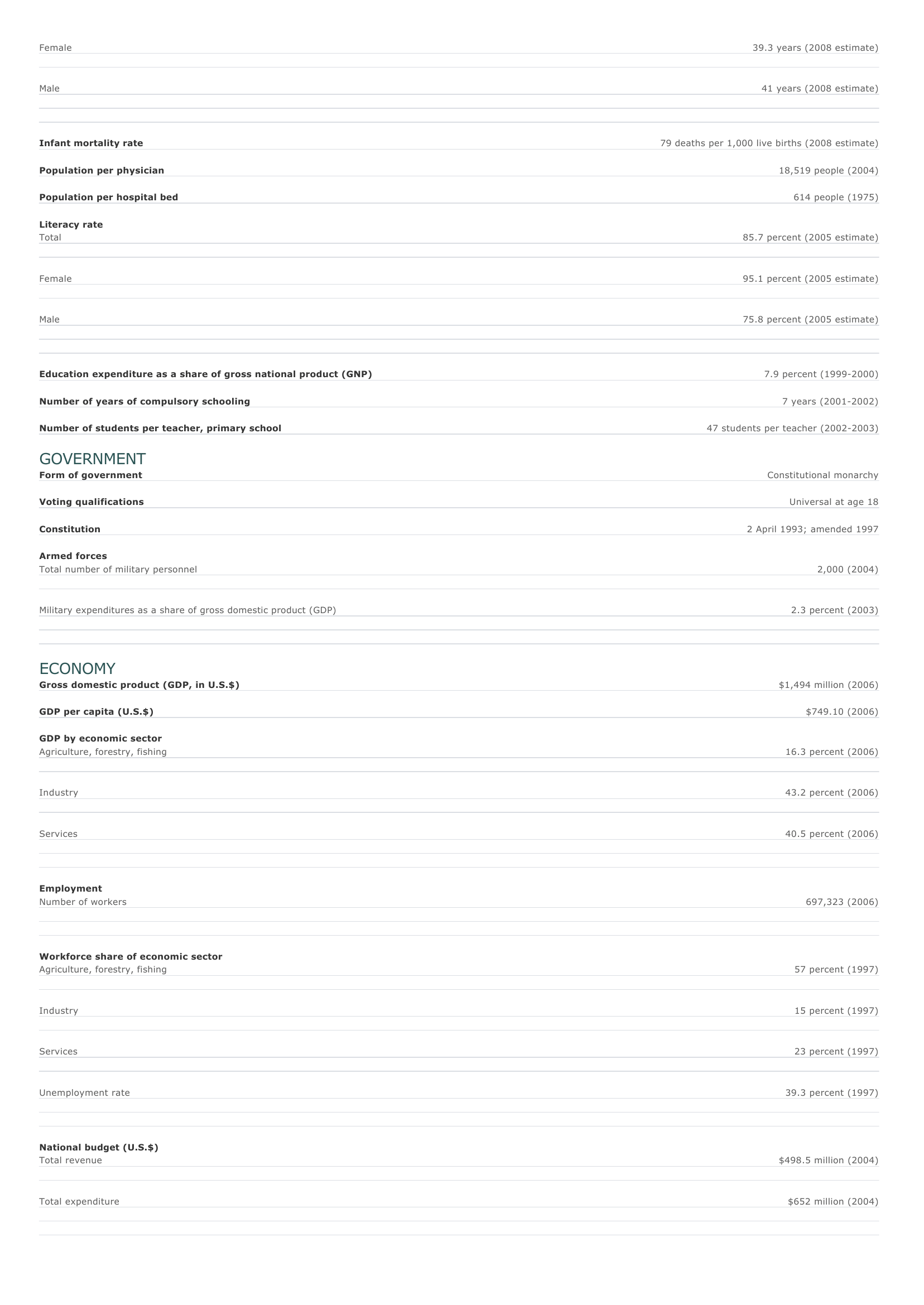Lesotho Facts and Figures. BASIC FACTS Official name Capital Area Kingdom of Lesotho Maseru 30,355 sq km 11,720 sq mi PEOPLE Population 2,128,180 (2008 estimate) Population growth Population growth rate 0.13 percent (2008 estimate) Projected population in 2025 2,119,170 (2025 estimate) Projected population in 2050 1,946,586 (2050 estimate) Population density 70 persons per sq km (2008 estimate) 182 persons per sq mi (2008 estimate) Urban/rural distribution Share urban 18 percent (2003 estimate) Share rural 82 percent (2003 estimate) Largest cities, with population Maseru 170,000 (2003 estimate) Ethnic groups Basotho 79 percent Nguni 20 percent San, Griqua, other groups 1 percent Languages Sesotho (southern Sotho, official), English (official), Zulu, Xhosa Religious affiliations Christian 91 percent Roman Caholic 38 percent Protestant 13 percent Anglican Other Christian 5 percent 35 percent Indigenous beliefs 8 percent O ther 1 percent HEALTH AND EDUCATION Life expectancy Total 40.2 years (2008 estimate) Female Male Infant mortality rate Population per physician Population per hospital bed 39.3 years (2008 estimate) 41 years (2008 estimate) 79 deaths per 1,000 live births (2008 estimate) 18,519 people (2004) 614 people (1975) Literacy rate Total 85.7 percent (2005 estimate) Female 95.1 percent (2005 estimate) Male 75.8 percent (2005 estimate) Education expenditure as a share of gross national product (GNP) Number of years of compulsory schooling Number of students per teacher, primary school 7.9 percent (1999-2000) 7 years (2001-2002) 47 students per teacher (2002-2003) GOVERNMENT Form of government Constitutional monarchy Voting qualifications Universal at age 18 Constitution Armed forces Total number of military personnel Military expenditures as a share of gross domestic product (GDP) 2 April 1993; amended 1997 2,000 (2004) 2.3 percent (2003) ECONOMY Gross domestic product (GDP, in U.S.$) GDP per capita (U.S.$) $1,494 million (2006) $749.10 (2006) GDP by economic sector Agriculture, forestry, fishing 16.3 percent (2006) I ndustry 43.2 percent (2006) Services 40.5 percent (2006) Employment Number of workers 697,323 (2006) Workforce share of economic sector Agriculture, forestry, fishing 57 percent (1997) I ndustry 15 percent (1997) Services 23 percent (1997) Unemployment rate National budget (U.S.$) Total revenue Total expenditure 39.3 percent (1997) $498.5 million (2004) $652 million (2004) Monetary unit 1 loti (L), consisting of 100 lisente Major trade partners for exports Southern African Customs Union countries Major trade partners for imports Southern African Customs Union countries, Taiwan, Japan, and Hong Kong SAR ENERGY, COMMUNICATIONS, AND TRANSPORTATION Electricity production Electricity from thermal sources Electricity from hydroelectric sources 0 percent (2003 estimate) 100 percent (2003 estimate) Electricity from nuclear sources 0 percent (2003 estimate) Electricity from geothermal, solar, and wind sources 0 percent (2003 estimate) Number of radios per 1,000 people 52 (1997) Number of telephones per 1,000 people 27 (2005) Number of televisions per 1,000 people 16 (2000 estimate) Number of Internet hosts per 10,000 people Daily newspaper circulation per 1,000 people Number of motor vehicles per 1,000 people Paved road as a share of total roads 0.55 (2003) 7 (1996) 19 (1997) 18 percent (1999) SOURCES Basic Facts and People sections Area data are from the statistical bureaus of individual countries. Population, population growth rate, and population projections are from the United States Census Bureau, International Programs Center, International Data Base (IDB) (www.census.gov). Urban and rural population data are from the Food and Agriculture Organization (FAO) of the United Nations (UN), FAOSTAT database (www.fao.org). Largest cities population data and political divisions data are from the statistical bureaus of individual countries. Ethnic divisions and religion data are largely from the latest Central Intelligence Agency (CIA) World Factbook and from various country censuses and reports. Language data are largely from the Ethnologue, Languages of the World, Summer Institute of Linguistics International (www.sil.org). Health and Education section Life expectancy and infant mortality data are from the United States Census Bureau, International Programs Center, International database (IDB) (www.census.gov). Population per physician and population per hospital bed data are from the World Health Organization (WHO) (www.who.int). Education data are from the United Nations Educational, Scientific and Cultural Organization (UNESCO) database (www.unesco.org). Government section Government, independence, legislature, constitution, highest court, and voting qualifications data are largely from various government Web sites, the latest Europa World Yearbook, and the latest Central Intelligence Agency (CIA) World Factbook. The armed forces data is from Military Balance. Economy section Gross domestic product (GDP), GDP per capita, GDP by economic sectors, employment, and national budget data are from the World Bank database (www.worldbank.org). Monetary unit, agriculture, mining, manufacturing, exports, imports, and major trade partner information is from the statistical bureaus of individual countries, latest Europa World Yearbook, and various United Nations and International Monetary Fund (IMF) publications. Energy, Communication, and Transportation section Electricity information is from the Energy Information Administration (EIA) database (www.eia.doe.gov). Radio, telephone, television, and newspaper information is from the United Nations Educational, Scientific and Cultural Organization (UNESCO) database (www.unesco.org). Internet hosts, motor vehicles, and road data are from the World Bank database (www.worldbank.org). Note Figures may not total 100 percent due to rounding. Microsoft ® Encarta ® 2009. © 1993-2008 Microsoft Corporation. All rights reserved.








